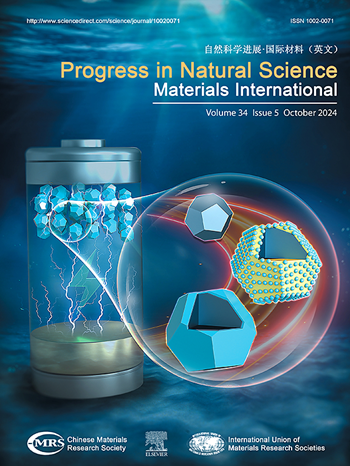三维氮掺杂双金属磷酸盐上部结构增强电化学储能
IF 7.1
2区 材料科学
Q2 MATERIALS SCIENCE, MULTIDISCIPLINARY
Progress in Natural Science: Materials International
Pub Date : 2025-04-01
DOI:10.1016/j.pnsc.2025.01.004
引用次数: 0
摘要
磷酸盐由于其大通道、优异的导电性和电荷存储能力而成为超级电容器阴极的有前途的候选者,引起了人们的极大兴趣。目前,氮掺杂被广泛用于实现磷酸盐的自定义性能。值得注意的是,双金属化合物的构建将通过金属之间的协同作用显著促进氧化还原反应,提高电极的循环稳定性。此外,与结晶相相比,非晶材料有潜力实现更高的比容量和循环稳定性,因为有许多氧化还原反应的活性位点和更高的机械强度。本文提出了一种氮掺杂的双金属磷酸盐Co0.5Ni0.5-NPO·nH2O,在氧气气氛中通过煅烧过程转化为无定形(a -Co0.5Ni0.5-NPO)。A- co0.5 ni0.5 - npo制备的电极在0.5 A g - 1时可达到134.98 mAh g - 1,具有优异的倍率性能。此外,还构建了a - co0.5 ni0.5 - npo //AC非对称超级电容器(ASC)器件,该器件的比容量为328 F g−1 (0.5 a g−1),并且具有出色的循环稳定性(在3a g−1下循环3000次后保持86.51%)。该研究为开发双金属磷酸盐作为增强储能系统所需的电极材料提供了有价值的见解。本文章由计算机程序翻译,如有差异,请以英文原文为准。
3D nitrogen doped bimetallic phosphate superstructure for enhanced electrochemical energy storage
Phosphates have sparked significant interest as a promising candidate for cathode of supercapacitors due to their large channels, superior conductivity and charge storage capacity. Currently, nitrogen doping is widely employed to achieve customized properties of phosphates. Notably, the construction of bimetallic compounds will remarkably promote redox reactions and improve the cycle stability of the electrode through synergistic effects between the metals. Furthermore, compared to crystalline phases, amorphous materials have the potential to achieve increased specific capacity and cycle stability because of numerous active sites for redox reactions and higher mechanical strength. Herein, a nitrogen-doped bimetallic phosphate Co0.5Ni0.5-NPO·nH2O is proposed, which is converted to the amorphous state (A-Co0.5Ni0.5-NPO) through the calcination process in an oxygen atmosphere. The electrode prepared by A-Co0.5Ni0.5-NPO achieves 134.98 mAh g−1 (at 0.5 A g−1) and outstanding rate capability. Furthermore, A-Co0.5Ni0.5-NPO//AC asymmetric supercapacitor (ASC) device with a specific capacity of 328 F g−1 (at 0.5 A g−1) and outstanding cycle stability (86.51 % retention after 3000 cycles at 3 A g−1) is constructed. The research provides valuable insights for developing bimetallic phosphates as desirable electrode materials for enhanced energy storage systems.
求助全文
通过发布文献求助,成功后即可免费获取论文全文。
去求助
来源期刊
CiteScore
8.60
自引率
2.10%
发文量
2812
审稿时长
49 days
期刊介绍:
Progress in Natural Science: Materials International provides scientists and engineers throughout the world with a central vehicle for the exchange and dissemination of basic theoretical studies and applied research of advanced materials. The emphasis is placed on original research, both analytical and experimental, which is of permanent interest to engineers and scientists, covering all aspects of new materials and technologies, such as, energy and environmental materials; advanced structural materials; advanced transportation materials, functional and electronic materials; nano-scale and amorphous materials; health and biological materials; materials modeling and simulation; materials characterization; and so on. The latest research achievements and innovative papers in basic theoretical studies and applied research of material science will be carefully selected and promptly reported. Thus, the aim of this Journal is to serve the global materials science and technology community with the latest research findings.
As a service to readers, an international bibliography of recent publications in advanced materials is published bimonthly.

 求助内容:
求助内容: 应助结果提醒方式:
应助结果提醒方式:


